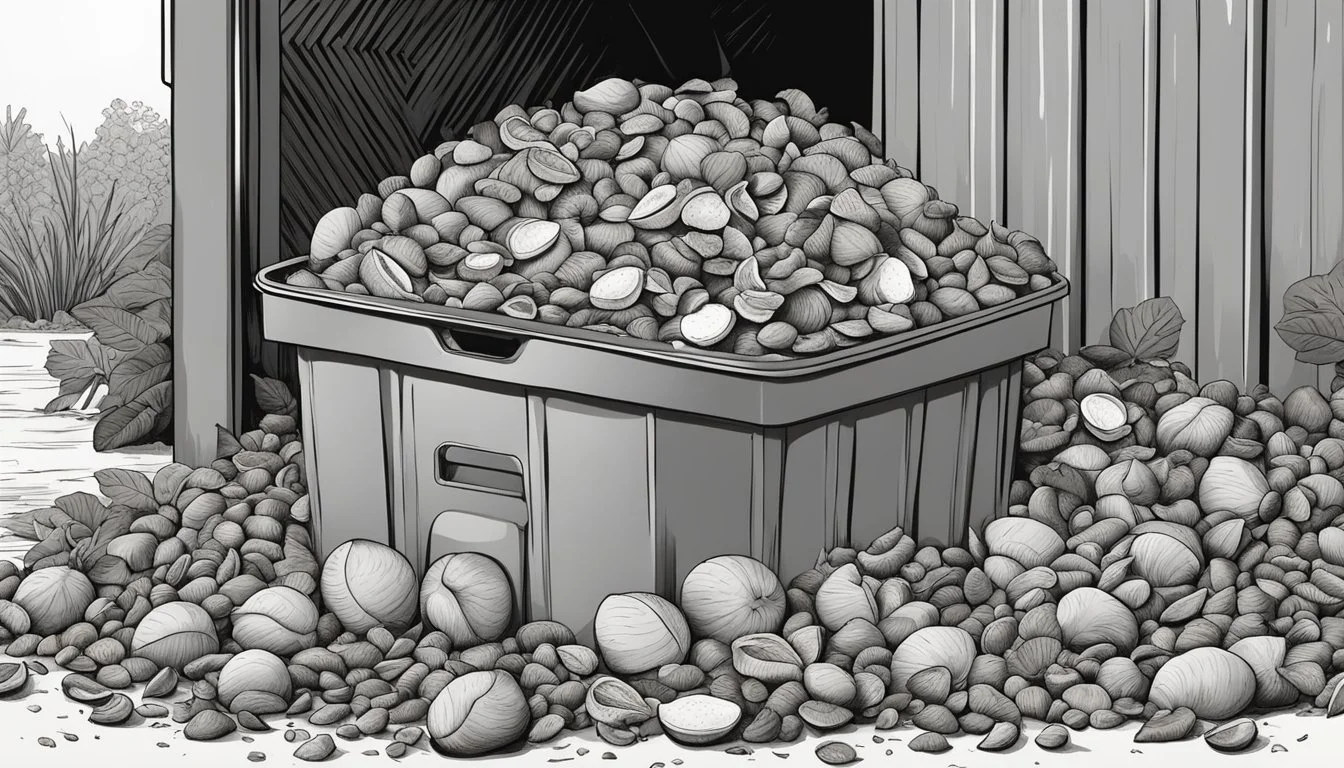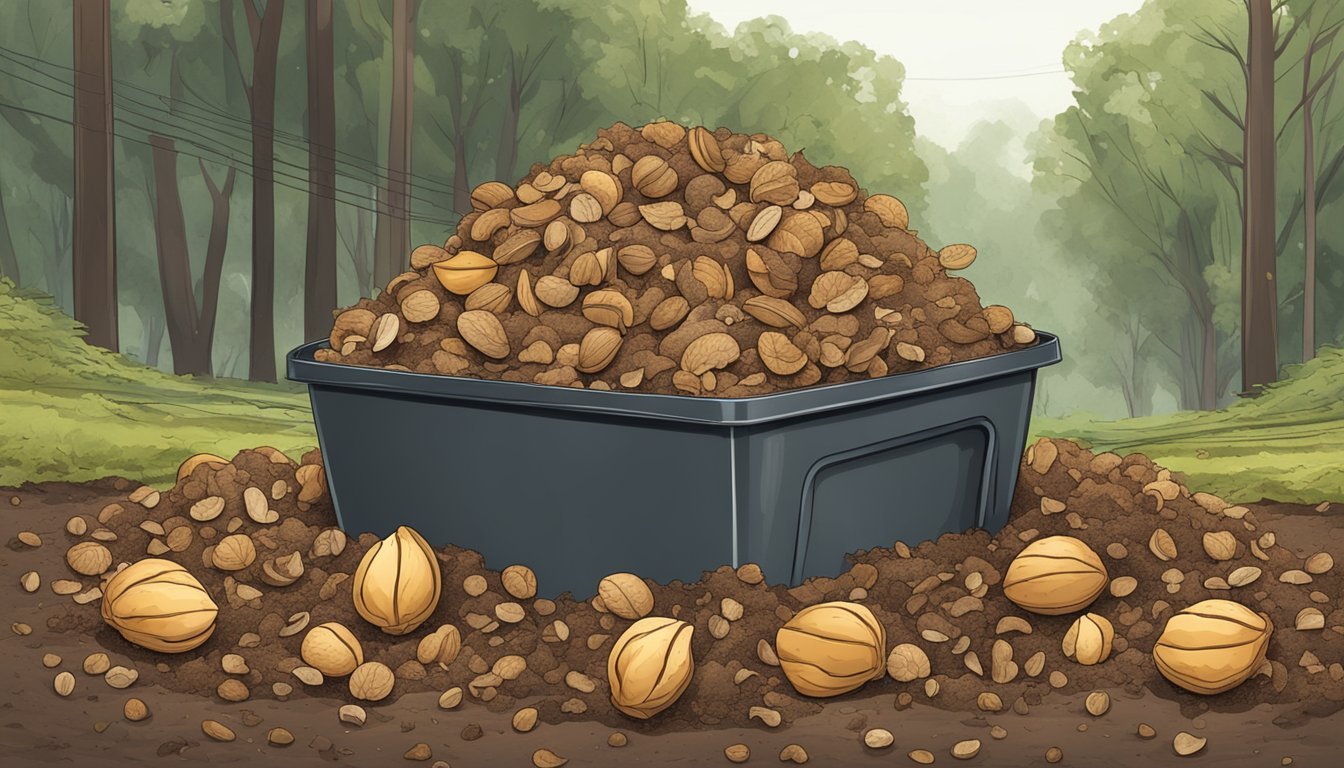Can You Compost Walnut Shells?
Unveiling the Truth About Nut Shell Composting
Composting is a process that transforms organic waste into nutrient-rich soil, benefitting gardeners and the environment. Nut shells, with their carbon-rich composition, are often included in compost piles. However, composting walnut shells warrants special attention due to the unique properties they possess. Walnut shells can be composted, but the process is not as straightforward as composting other organic matter.
Walnut trees produce a chemical called juglone, which is found in all parts of the tree, including the shells of the nuts. Juglone is a natural herbicide that can inhibit the growth of certain plants, which raises concern about the use of walnut shells in compost. Although this substance can be problematic, composting walnut shells is possible with careful consideration.
The key to successful composting of walnut shells lies in their breakdown. Over time, the juglone degrades, especially when exposed to elements like air, water, and bacteria found in compost piles. This degradation minimizes the risk of the chemical affecting sensitive plants. To accelerate the process and ensure a safe, nutrient-dense compost, it's essential to break down the shells into smaller pieces and to allow sufficient time for them to decompose.
Composting Basics
Composting is an essential process for transforming waste into a resource. This section explores the foundational aspects of composting, guiding readers through its benefits and methodologies.
What Is Compost?
Compost is a type of soil amendment made from decomposed organic materials. It enriches garden soil by adding nutrients, improving soil structure, and enhancing moisture retention.
Benefits of Composting
Composting benefits the environment by reducing waste in landfills and enriching the soil. It contributes to a nutrient-rich soil that is beneficial for plant growth, enhancing the overall health of a garden.
Composting Methods
There are primarily two methods of composting:
Hot composting, which is a faster process requiring active management, involves maintaining high temperatures to speed up decomposition.
Cold composting is less intensive and involves simply piling up garden and kitchen waste and allowing it to break down over time.
Both methods require a balance of materials and conditions to be effective.
The Science of Decomposition
Decomposition in composting is facilitated by bacteria, fungi, and other organisms. These microorganisms require oxygen and moisture to thrive and break down organic materials into compost. The process also produces heat, which further aids in decomposition.
Understanding Carbon to Nitrogen Ratio
The carbon to nitrogen (C) ratio is vital for efficient composting:
Brown materials provide carbon and include items like dried leaves and nut shells.
Green materials provide nitrogen and consist of items like food scraps and fresh plant matter.
An optimal balance of roughly 25–30 parts carbon to one part nitrogen is often recommended for compost piles. Maintaining this ratio ensures a faster decomposition process and produces high-quality compost for use in garden soil.
Specifics of Composting Nut Shells
Composting nut shells can be a beneficial practice for soil enrichment, but it is important to understand their specific decomposition properties and effects on compost quality.
The Nature of Nut Shells
Nut shells are inherently woody and tough, making them a carbon-rich "brown" material for compost. Their structural rigidity is advantageous for aeration and can improve the overall composition of compost by adding bulk. However, due to their density, nut shells decompose at a much slower rate than other organic materials, typically taking 6 to 24 months to break down completely.
Walnut Shells in Compost
Walnut shells are a specific case within the gamut of nut shells. They contain juglone, a natural compound that is toxic to certain plant species. The inclusion of walnut shells in compost should be approached with caution, as the juglone can potentially harm or inhibit the growth of sensitive plants.
Composting Other Nut Shells
Aside from walnut shells, other types of nut shells such as peanut shells, pistachio nut shells, and almond shells can be safely added to compost piles. Pistachio shells in particular are noted for their ability to act as a bulking agent, which helps to maintain an open structure for airflow within the compost. It is important to note that like walnut shells, other nut shells will also take a longer time to decompose due to their woody nature.
Optimizing Compost Conditions
When composting walnut shells, one must optimize conditions to facilitate decomposition and maintain a balance of materials. Accurate control of moisture, oxygen flow, and a mix of greens and browns are vital.
Improving Decomposition Process
The decomposition of walnut shells can be enhanced by ensuring an adequate amount of moisture. Walnut shells are particularly tough and, therefore, require constant moisture to break down effectively. However, too much moisture can lead to a lack of oxygen, which slows down the composting process. To achieve this balance, the compost should have the consistency of a wrung-out sponge.
Incorporating materials that promote oxygen flow is crucial for a healthy compost system. Turning the compost pile regularly will introduce oxygen, which is essential for microbial activity. Adequate aeration aids in breaking down tougher materials like walnut shells while also preventing unpleasant odors.
Balancing Compost Materials
Achieving the right balance between carbon-rich "brown" materials and nitrogen-rich "green" materials is imperative for efficient composting. Walnut shells, being high in carbon, should be balanced with nitrogenous materials like leaves, grass, food scraps, and coffee grounds. A typical ratio to aim for is approximately 30 parts carbon to 1 part nitrogen.
Browns (Carbon-rich): Walnut shells, sawdust, paper
Greens (Nitrogen-rich): Vegetable scraps, grass clippings, coffee grounds
Regularly mixing these materials will not only balance the compost but also speed up the decomposition of tough nut shells like those from walnuts.
Potential Issues and Solutions
Walnut shells can be composted, but their high content of juglone and hardy nature present specific challenges. Addressing toxicity, promoting efficient decomposition, and controlling pests are critical for successful composting of walnut shells.
Addressing Juglone Toxicity
Juglone is a naturally occurring compound in walnut shells that can impede the growth of sensitive plants. To mitigate juglone toxicity, it's advisable to let walnut shells age and break down before being incorporated into the compost pile. This process can neutralize juglone over time. Gardeners should also be aware that plants like tomatoes can be particularly sensitive to juglone and must be planted at sufficient distances from compost that contains walnut shells.
Dealing with Slow Decomposition
Walnut shells are dense and decompose slowly. To speed up this process, shells should be crushed or ground into smaller pieces. Adding nitrogen-rich materials, such as vegetable scraps or grass clippings, can also help accelerate decomposition. Mixing smaller quantities of sawdust or twigs ensures a balanced compost environment that promotes microbial activity to break down the shells more efficiently.
Controlling Pests and Diseases
Compost piles with nut shells might attract various pests and be susceptible to diseases. Regular turning of the compost pile is essential in maintaining an aerobic environment where beneficial microorganisms thrive and outcompete harmful pests. Insects and diseases are less likely to become an issue in well-managed compost that maintains appropriate moisture and temperature levels. If pests do appear, identifying them promptly and responding with environmentally friendly controls is crucial.
Environmental Considerations
When composting walnut shells, one should contemplate the dual benefit it offers – reducing landfill waste and supporting eco-friendly gardening practices through effective nutrient cycling.
Reducing Landfill Waste
Walnut shells are organic materials that are compostable and biodegradable. Composting these shells helps divert them away from landfills, where organic materials often take up significant space and contribute to the production of methane, a potent greenhouse gas. By breaking down the shells in a composting environment, one can reduce their environmental footprint. Furthermore, walnut shells decompose over a longer period compared to other compostable items, which means they provide structure and aeration to the compost mix, improving its quality.
Eco-Friendly Gardening Practices
In addition to their compostability, walnut shells can contribute to eco-friendly gardening practices. Their eventual decomposition adds valuable nutrients back to the garden soil, enhancing its quality. However, gardeners must exercise caution due to the natural compound juglone found in walnuts, which can inhibit the growth of sensitive plants. Therefore, it's important to:
Verify: Ensure that the plants in your garden are not susceptible to juglone.
Compost Correctly: Allow walnut shells sufficient time to decompose and the juglone to degrade before using the compost.
Properly managed, composting walnut shells aligns with environmental stewardship and sustainable gardening efforts, ensuring that one actively participates in creating a healthier ecosystem.
Practical Composting Tips
In this section, practical steps are outlined for incorporating walnut shells into compost, maintaining a healthy compost heap, and using the finished compost as a soil amendment.
Incorporating Walnut Shells
Walnut shells, particularly from walnuts, can add valuable nutrients and texture to compost. Crushing the shells into smaller pieces will accelerate decomposition as it increases the surface area. Due to their hardness, walnut shells decompose slowly, so it's recommended to crush them prior to adding to your compost bin to hasten this process. One should also be cautious with walnut shells, which contain juglone, a compound that can inhibit plant growth. This means it's important to ensure that the shells are well-composted before use as mulch or soil amendment.
Maintaining Your Compost Heap
Ensuring a successful decomposition of walnut shells, as well as other compost materials, hinges on maintaining proper moisture, temperature, aeration, and nutrient balance within the compost heap. The compost should remain as moist as a wrung-out sponge, which might entail watering during dry periods. Balance is key; include a mix of green (nitrogen-rich) and brown (carbon-rich) materials, to which walnut shells contribute greatly as brown material. Aeration is crucial as it supplies oxygen that microbes require to break down the components; therefore, turn the heap regularly to maintain airflow.
Ideal Moisture: Approximately 40-60%
Ideal Temperature: Between 135-160°F (57-71°C) to effectively kill pathogens and seeds
Balance: Aim for a carbon to nitrogen ratio of 30:1
Using Finished Compost
After thorough decomposition, the compost containing walnut shells is ready to enhance garden soils. It should be free of any discernible walnut pieces and have a rich, earthy smell indicating decomposition is complete. Apply the finished compost to garden beds to improve soil texture and nutrient availability for better plant growth. As a precaution due to the risk of juglone, use this compost primarily on plants that are known to be tolerant to it.
Conclusion
Composting Walnut Shells: A Summary
While walnut shells can be composted, gardeners should proceed with caution. Walnut shells contain juglone, a natural compound that is toxic to some plant species and can inhibit their growth. This allelopathic chemical's effects vary, with some plants being more susceptible than others.
Decomposition Rate: Walnut shells are hardy and decompose slowly. Therefore, they require a lengthy composting process to break down fully. Crushing the shells can speed up decomposition.
Guidelines for Gardeners
Juglone Consideration: Gardeners need to be aware of juglone's potential effects and should:
Identify: Determine which plants in their garden are sensitive to juglone.
Monitor: Keep an eye on the health of these plants if walnut shells are included in the compost.
Composting Process:
Aerate: Regularly turn the compost to ensure adequate oxygenation.
Balance: Mix green materials, like vegetable scraps, with brown materials, like walnut shells, to maintain the compost's balance.
Nutrient Contribution: Walnut shells add carbon to the compost, which is beneficial for building soil structure and fertility over time.
Safe Application
For gardeners considering using composted walnut shells:
Test: Introduce a small amount of the compost to part of the garden and observe the results before widespread application.
Timing: Allow sufficient time for juglone to degrade, which can reduce potential plant toxicity.
By adhering to these considerations, gardeners can responsibly incorporate walnut shells into their composting efforts.






